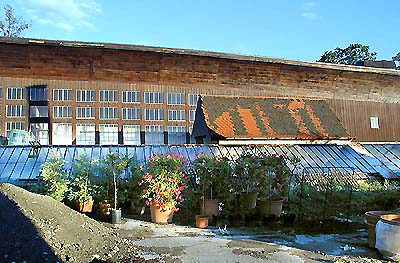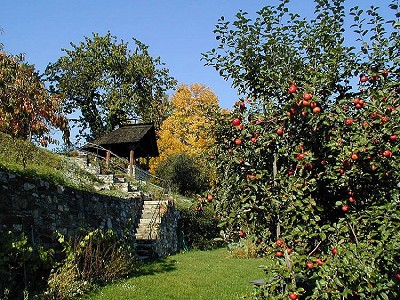Supply Gardens
Location :
The supply gardens of the castle administration are situated on the
southern edge of the castle grounds on the border of the former
Vltava river terraces and the adjacent slopes with eastern
exposure.
It is delimited on the northeast by a deep ravine above the river, while the northwest border runs along the path connecting the castle gate on the Vth Courtyard of Český Krumlov Castle and the crossroad at the beginning of Důlní street. This route demarcates the gardening space on the southwest, running parallel with the circumscribing wall of the castle\'s garden. In the so-called building "paraplíčko" (Paraplíčko - fortification) the wall breaks off and reassumes on the edge of the field above the slope towards the Vltava.
Local names :
The garden had been previously known under other names as well:
"plášťová garden", "garden Na plášti" (in German Mantelgarten),
"kitchen garden" (in German Küchengarten), and "garden above
Rybářská street".
Description :
The area contains the following structures :
- Castle No. 61 - Orangery with a one-storey house of the castle gardener
- the Old Pineapple Greenhouse
- barn (so-called labuťárna, swan\'s abode)
- the paraplíčko- fortification and reassuming circumscribing walls
- the garden arbour by no.61
- the garden arbour (so-called Bavarian "salet") on the lower terraces.
Historical development of the construction
:
The area of the kitchen garden "Na plášti" was, evidently,
originally the uncultivated southwestern front area of the Český
Krumlov castle.
The oldest building is the fortification in the southwest corner of the area, probably originally from the second half of the 15th century. This building could have been part of the external fortification (so-called Nový Plášť) built by Ulrich II. von Rosenberg (mentioned from the year 1447).
Under the reign of the last Rosenberg, the decrepit fortification system was evidently torn down, the ramparts taken away and the ditches filled up. The new circumscribing wall with the false castigated wall on the crest was built from the ruins of the original wall. The so-called plášťová gate and the northern fortification section (where the castle garden is located today) was still standing at that time.
We find the following description from 1600: "above the castle and in the castle surroundings were planted 3 large orchards with good trees bearing all kinds of fruits and various spices and flowers" - it is possible to suppose that the location of the utilised garden was on the site of today\'s supply garden. Nevertheless the first written reports about the "garden above the Rybářská street" date from the year 1657. It is supposed that the garden was founded in the first half of the 17th century and had an agricultural character.
After the troubled period of the 30 years war, the mediocre care of the garden didn\'t undergo any fundamental changes until the reign of prince Johann Christian I. von Eggenberg. In connection with the foundation of the castle garden the prince also bought up pieces of land belonging to the bourgeois in the so-called plášťová or also kitchen garden.
It is probably here (that is on the area of today\'s gardens) that the gardening storehouse and further operational gardening rooms were set up.
The shape of plášťová garden (in original German Mantelgarten) is referred to in coarse detail in a plan dated about the year 1702 showing in detail the gardening circumscribing wall corresponding precisely even to today\'s state.
Grapevines were cultivated in the garden (but also in the castle\'s own garden). As early as 1692, one hundred seedlings of grape-wine were planted here, imported from the prince\'s vineyard in Austrian Senftenberg.
A report from the year 1732 mentioning the intensity of the gardening activity remarks that three gardening journeymen, 6 assistant gardeners and 20-30 workers were working daily.
A report from the year 1755 mentions the purchase of seeds for the kitchen garden "Na plášti".
Reports of gardening furniture come more frequently only from the beginning of the 18th century, at which time a series of hot-beds, greenhouses, orangeries, and a house for the gardener were built and a great deal was devoted to the business of gardening.
In 1766 the garden was enclosed with a fence on the Vltava side (after bad experiences with thieves). A water system from Dubík was installed in the same year, which among others supplied the kitchen garden with water as well (see Castle Waterworks).
Many exotic plants were grown in the garden, as is referred to in an inventory dated 10.7.1766. The enumeration contains 168 pieces of different varieties of lemon-trees, 91 orange trees, 2 "grenade trees" (also marhaník) and 151 laurels in the orangery, in the large greenhouse were cultivated 181 pineapples and 135 almost undefined plants form America (evidently Agave), and the small greenhouse housed 70 pieces of pineapples and 110 other flowers.
In the year 1800 the house of the gardener was raised one floor and a long ground-floor wing for the assistant gardeners was arranged. In the same period an open shed along the southwest circumscribing wall was built, later to be rebuilt on the barn (nowadays the so-called "labuťárna").
The observation point, set up on the site of the old bastion in the year 1824 (the so-called paraplíčko-fortification) was connected with the promenade road of the castle running approximately along the contour line of the slope above the Vltava. Some wooden walkways made from planks were build for comfortable strolling, and were provided with a hand-rail. Sight-seeing terraces offering attractive views onto the town and the castle as well as arbours were set up on the promenade (see Renewal study for the Rybářská area).
The garden terraces on the eastern side of the garden were allotted as "deputy gardens" to high officials from the beginning of the 19th century. Small garden buildings and arbours were built for the individual users, out of which two dating from the beginning of the 20th century are still preserved.
The second period of the expansion of gardening activity came in the 1840\'s, when the pineapple greenhouses were built and the orangery was rebuilt.
During the second half of the 19th century, a weakened economy affected even gardening; a part of the orangery was demolished, and in certain greenhouses flowers were no longer cultivated. The continuity of gardening activity, nevertheless, has been conserved up to the present.
Contemporary use :
In the rebuilt orangery and the old greenhouses, plantations for
flower-beds in the castle\'s garden are cultivated as well as
decorative flower-pots for the decoration of the castle\'s
interiors and court.
(jo)




